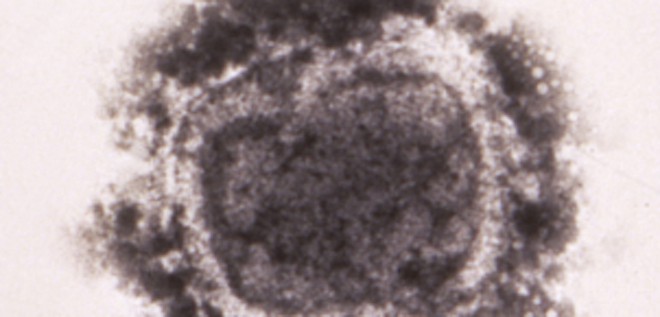
 Variola, CDC
Variola, CDC
I was away reporting most of today, and while I was out, a few federal emails landed in my mail with what probably sounded like a thud. One was an official announcement from the Food and Drug Administration; the others were copies of FDA and NIH emails that people there thought I should see.
They all said the same thing: The six vials of smallpox virus found in an FDA cold-storage room on the National Institutes of Health campus July 1 and announced by the CDC last week had company. A lot of company: 321 other vials. Some of them contained other “select agents,” infectious pathogens considered serious enough — for the illness they create, or the lack of a vaccine to prevent or drugs to treat them — to be considered potential bioterror agents.
(If you’ve missed this story so far, catch up here, here, here and here.)
Here’s the gist of the FDA’s external announcement:
The investigation found 12 boxes containing a total of 327 carefully packaged vials labeled with names of various biological agents such as dengue, influenza, Q fever, and rickettsia. Upon the discovery of these vials on July 1, 2014, FDA employees followed standard protocol and turned them all over to the appropriate NIH safety program officials, who in turn transferred them to the appropriate investigative agencies, as per standard protocols.
As announced on July 8, 2014, six vials labeled “variola” (the causative agent of smallpox) along with ten other samples with unclear labeling were transported safely and securely with the assistance of federal and local law enforcement agencies in a government aircraft to CDC’s high-containment facility in Atlanta. In addition, 32 samples were destroyed following inventory at the NIH facility, including 28 labeled as normal tissue and four labeled as “vaccinia,” the virus used to make the smallpox vaccine. To be clear, vaccinia does not cause smallpox. These vials represented no value to forensic sciences and were destroyed according to standard protocols.
The remaining 279 biological samples were then transferred by the investigating agencies to the U.S. Department of Homeland Security’s National Bioforensic Analysis Center for safeguarding. There were no smallpox samples included in this transfer. The FDA received confirmatory information about the samples yesterday, thus permitting public disclosure of this additional information.
The rest of the announcement confirms what my reporting uncovered last week: The room where the vials were found, though now belonging to the FDA, was once the property of NIH’s Division of Biological Standards, which worked on the reliability of vaccines:
…this collection was most likely assembled between 1946 and 1964 when standards for work with and storage of biological specimens were very different from those used today. All of the items labeled as infectious agents found in the collection of samples were stored in glass, heat-sealed vials that were well-packed, intact, and free of any leakage, and there is no evidence that anyone was exposed to these agents.
The internal NIH announcement, signed by director Dr. Francis Collins, goes into detail about what comes next:
…the safety of NIH employees and the public is of utmost importance and overlooking such a sample collection for years is clearly unacceptable. We take very seriously this incident and our need to apply a number of responsive new precautionary measures. As you know, we are instituting a comprehensive search of our facilities to identify any other select agents, toxins, or hazardous biological materials improperly stored in any of our facilities, owned, leased, or through contract arrangements. We have developed a plan of action for the conduct of this search: it requires investigators to examine all freezers, refrigerators, cold rooms, storage shelves, and cabinets, as well as all other areas of storage such as offices associated with laboratories, to be sure that there are no further examples of potentially harmful materials that are being improperly stored.
Much more to come, no doubt.
Meanwhile, as I mentioned this morning, leadership from the Centers for Disease Control and Prevention were in front of Congress today to explain the other two infectious-organism misfires that are happening coincident to this: the errors in the CDC’s anthrax and influenza labs. Here is the video of the full session (2 hours, 40 minutes) in the House of Representatives. I haven’t had the chance to watch it yet; I’ll just leave it here for you: